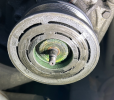Flossie
Well-Known Member
- Posts
- 11,352
- Location
- Shropshire
Around 18 months ago I had the ac regassed at kwikfit as it wasn't working, it then did, yay! But only for a few weeks, boo!.
Took it to my local indy and they reported condensor leaking, I fitted a new condensor and new pipe between compressor and condensor(a known mod is to fit the earlier deeper condensor as the later type is not available but needs the new pipe too plus a bit of bracket trimming). Back to the indy and reported no leaks and regassed the system, all working yay!
First hot day this year and it's not working again, boo!
Yesterday I poked the filler valve? The one on the bulkhead with the black plastic screw on cap and there is no gas.
I don't want to be coughing up every year and I want to appear a little knowledgeable to an ac guy and make a knowledgeable suggestion of some how testing the system a little better for leaks without sounding like a tit. I've got a uv torch which I was going to shine around stuff tonight when it's darker but I don't know if the indy even put dye in .
Took it to my local indy and they reported condensor leaking, I fitted a new condensor and new pipe between compressor and condensor(a known mod is to fit the earlier deeper condensor as the later type is not available but needs the new pipe too plus a bit of bracket trimming). Back to the indy and reported no leaks and regassed the system, all working yay!
First hot day this year and it's not working again, boo!
Yesterday I poked the filler valve? The one on the bulkhead with the black plastic screw on cap and there is no gas.
I don't want to be coughing up every year and I want to appear a little knowledgeable to an ac guy and make a knowledgeable suggestion of some how testing the system a little better for leaks without sounding like a tit. I've got a uv torch which I was going to shine around stuff tonight when it's darker but I don't know if the indy even put dye in .


